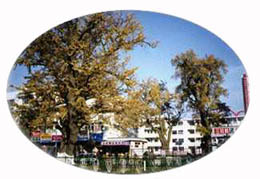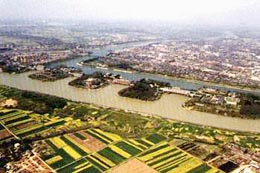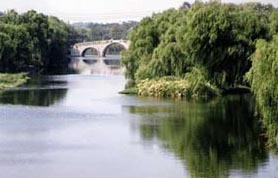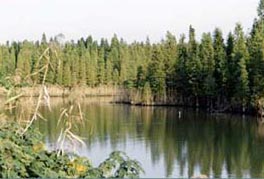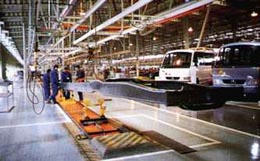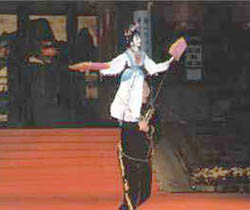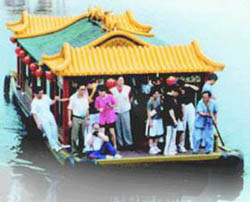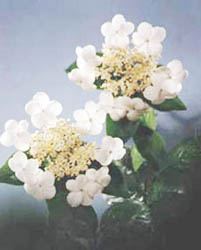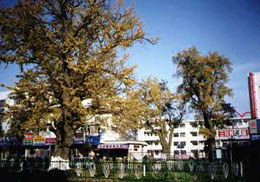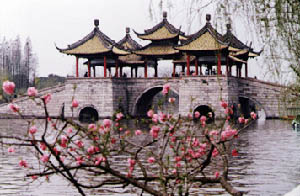History Yangzhou
Yangzhou, one of China's famous historical and cultural cities, has long been eulogized as "famous city on Jianghuai Plain". The city began to be built in 486 B.C. during the Spring and Autumn Period. So far it has a history of over 2,480 years. In the past, Yangzhou was named Hangou, Guangling, Jiangdu, Wucheng and Weiyang.
Yangzhou was one of the country's nine natural regions in remote antiquity. It became not only a political and military base of southeastern China in the Eastern Han Dynasty (25-220), |
|
but also an important distribution center of grain, salt and iron in China, and a major harbor as well because of its favorable location in the Jianghuai Plain.
Since ancient times, Yangzhou has been a tourist city. From as early as the Six Dynasties (222-589), there was an old saying "to visit Yangzhou by riding on a crane, one has to tie myriads of strings of coins around the waist", which means that Yangzhou is really an amazing land while you have to spend a lot of money.
Yangzhou has been the ideal place to be frequently visited by men of letters and scholars since ancient times. In the Tang Dynasty, it lured numerous celebrities and scholars. Its ancient civilization and splendid culture even aroused the emperors' interest in touring the city.
It is said that the Emperor Yang of the Sui Dynasty visited Yangzhou three times for appreciating the city's rare flowers, and the emperors Kangxi and Qianlong in the Qing Dynasty (1644-1911) had been to the city six times each. Their visits made many places of interest in Yangzhou famous nationwide. Nowadays, these sites have become the most valuable tourist resources in developing the city's tourist industry.
Now the ancient Yangzhou City has rejuvenated its vigor, greeting its tourists from home and abroad with a new look.
Geography Yangzhou
|
Located in the central Jiangsu Province, Yangzhou stands by the north bank of the Yangtze River at the southernmost part of the Jianghuai Plain. It is located 119°01'-119°54' east longitude and 31°56'-33°25' north latitude. It faces the Yangtze River on the south, and borders Huaiyin and Yancheng on the north, Yancheng and Taizhou on the east, and Tianchang (in Anhui Province), Nanjing and Huaiyin on the west. |
Yangzhou has 80.5 kilometers of coastal line along the Yangtze River. The Grand Canal from Beijing in the north to Hangzhou in the south passes through the city proper, totaling 143.3 kilometers. Actually, Yangzhou is right at the junction of the Yangtze River and Beijing-Hangzhou Grand Canal.
Yangzhou covers an area of 6,638 square kilometers with its city proper and its planned area being 148 and 360 square kilometers respectively. It has hilly land in Yizheng Hanjiang and the northern suburbs, the riverside areas in the east of the Canal and in the north of Tongyang Canal, and plains along the Yangtze River and the lakes. It has big lakes spread over such as White Horse Lake, Baoying Lake, Gaoyou Lake and Shaobo Lake.
Climate Yangzhou
Yangzhou features humid climate in the subtropical zone, and its annual average temperature is 15?. In July, its average temperature is 27.6?. The coldest month is January, with an average temperature of 1.5?.
The frost-free season is about 222 days, and its duration of yearly sunshine is about 2,176.7 hours. |
|
In Yangzhou winter lasts from December to February, spring from March to May, summer from June to August, and autumn from September to November. The annual average precipitation is 1,030 millimeters, and about 45 percent of rainfall is concentrated in summer, 9.5 percent in winter and 22-23 percent in spring and autumn respectively. The rainy season known as "plum rain season" usually lasts from mid-June to late July. During this season, plum is ripening, hence the name plum rain.
Natural and Ecological Environment Yangzhou
|
With a reputation of being a foliage corridor, Yangzhou is a famous historical and cultural city in China, also a tourist city with a traditional characteristics, rated as a garden city at provincial level named by the Jiangsu provincial government in February 1997.
By the end of 1998, the green coverage of the city was 1,657.9 hectares, while the public green belt area was 328.8 hectares and its coverage rate amounted to 35.2 percent. The per-capita public green area was 8.16 square meters.
|
With unremitting efforts dedicated to the initiative of becoming one of the Top Tourist Cities of China, and setting an example as a sanitation city designated by the State, the local government has strengthened the construction of the city's infrastructure and sanitation facilities, while doing solid work in terms of the city's purification and beautification.
The rate of daily life waste treatment was over 80 percent. The noise level at scenic spots is on average lower than 60 db and the indices of air pollution in the city are all below 100. The rate of quality drinking water exceeds 96 percent.
Economy Yangzhou
Since the founding of New China, especially since the reform and opening-up policy was carried out, which was set at the Third Plenary Session of the 11th CPC Central Committee, Yangzhou has witnessed an industrial system focusing on the machinery, food, textile and chemical industries formed, with numerous products winning top-quality prizes at State, ministerial and provincial levels respectively. |
|
In 1997, the total output value of GDP throughout the city was 37.671 billion yuan. The condition of farm production has been further improved, so that the annual added value of agriculture, forestry, animal husbandry and fishery industries was 5.906 billion yuan.
The total output of grain was 2.43 million tons, along with 23,300 tons of cotton, 76,800 tons of oil materials and 3,900 tons of silkworm cocoons. The annual added value of industry reached 16.42 billion yuan, the annual output value of light industry was 16.062 billion yuan, that of the heavy industry 24.456 billion yuan and township enterprises 50.518 billion yuan.
The local authorities have continuously expanded the scope of exports, with much headway in exploring foreign markets. The export volume managed by Yangzhou itself amounted to US$648 million; the number of newly-approved projects using foreign funds was 54, with US$214 million of capital actually used, generating US$18.69 million worth in foreign trades in 1997. The income of foreign tourism totaled US$22.49 million. The financial revenue in the same year was 2.279 billion yuan, 365 million yuan of which went to the insurance business.
A large expansion has been witnessed in communications and transportation. The volume of freight transportation by various means amounted to 4.923 billion tons/km, the passenger transportation 3.485 billion person/km and the harbor cargo handling capacity was 5 million tons.
The business volume of post and telecommunications services in 1997 was 832 million yuan, with switchboard capacity totaling 8.28 million. At present, the information harbor project in Yangzhou is under construction.
Culture Yangzhou
|
Yangzhou, a fertile land with a sound environment for fostering numerous refined scholars, is a famous cultural city where many talented persons gather. Among masterpieces of poems and essays, many highly praised the best scenery of Yangzhou.
It is the blue water of the Grand Canal that has brought up numerous writers and poets. Especially, the verse of "Willow Catkins and Flowers in March" lavished praise on the local flavor of the ancient city. |
Therefore, Yangzhou is well known to the public not only because it has numerous landscapes, but also for its many scholars and masterpieces. So, it has helped Yangzhou win a reputation as full of beautiful things to be appreciated.
The Yangzhou culture not only has an important bearing on the value of cultural relics, but has already been considered a tradition and trend permeating the blood of local people. It is an open culture in a comprehensive and creative way. Yangzhou drama storytelling in a local dialect, and puppet show are cultural forms favored by the local people. The inscriptions in ancient books belong to the precious cultural legacy of Yangzhou, while the calligraphy and paintings from the Eight Eccentric Artists of Yangzhou have far-reaching influence on the art of Chinese drawing in modern times.
The abundant cultural resources accumulated through thousands of years in Yangzhou have laid a cultural foundation for the current economic and social development. This has also created a sound environment for building Yangzhou into a prosperous, economically developed, well off and highly civilized city with an all-round legal system.
A Survey of the Tourist Industry Yangzhou
Lying in the center of Jiangsu Province, Yangzhou borders the bank of the Yangtze River on the south, Huaihe River on the north and with the Beijing-Hangzhou Grand Canal running across in the middle.
With a long history and flourishing culture, it is blessed with pleasant weather and elegant natural landscapes. The city, rich in numerous cultural and historical sites and ample tourist resources, |
|
is one of the 24 cultural and historical cities first approved by the State Council as an important open and tourist city along the Yangtze River Delta.
The local tourist industry began in 1978. Since implementing the policy of reform and opening up, the local authorities have accelerated the development pace and made remarkable progress in the construction of scenic spots and landscape areas, infrastructure and transportation.
Now, the city has 20 tourist hotels, 13 of them star-rated hotels, comprising one four-star, five three-star, six two-star and one one-star-rated hotel. The construction of another batch of multiple star-rated hotels has begun.
The number of various travel agencies in the city has risen to 28, three of which are international travel agencies. There are 15 designated restaurants, shopping centers and enterprises for tourists coming to Yangzhou.
Yangzhou has a great many cultural relics left by history, with one scenic spot at State level, three key units of cultural relics under State protection, 11 units of cultural relics at provincial level and 133 at city level.
In recent years, the local government has restored certain gardens and historical sites including the Twenty-four Bridge Scenic Spot, Running Water Flowing from Stone Cliffs, Granite-Built House, Bright Moon Tower, Rockery Garden.
In 1998, it began renovations and improvements on 10 scenic areas and opened them to the public, including the Museum of Han Grave, Tomb of Emperor Yang of the Sui Dynasty (581-618), the Memorial Hall of the Eight Eccentric Artists, Gaomin Temple, Longevity Temple, Puhading Tomb, Heyuan Garden, Geyuan Garden, Lotus-Pond Park and Qiong Flower Temple.
The local tourist organizations respectively Introduced some eight itinerary routes entitled Emperor Qianlong's Lake Cruise, ancient Grand Canal Cruise, Religious Cultural Tour, Tour to Appreciate the Culture of A Dream of the Red Mansions, Adventure Tour of the Eight Eccentric Artists of Yangzhou, Tour to Ancient Gardens and Forests. Of them, the Emperor Qianlong's lake cruise was designated as the key itinerary line throughout the country by China National Tourism Administration.
In order to offer convenience for free and individual travelers, the local authorities set up the Two-day Tour Co., in conjunction with sightseeing buses and standardized services to create an atmosphere for urban tourism.
In conjunction with the China Ecotour'99, the local government developed the Happy Fisherman Tour of Gaoyou Lake, introducing a series of recreational items including herding wild ducks, observing birds tour on fishing boats, roaming by motor boats and tour to log cabins in the forest.
Furthermore, it has conducted investigations to outline certain new tourist items on the basis of the above-mentioned items: (1) a newly built landscape belt of the ancient Grand Canal so as to perfect the itinerary; (2) the Zhuyu Bend Tourist Resort; (3) A Museum of the Ruins of Yangzhou City in the Tang Dynasty; (4) plan to build museums of the development and taxation of salt industry.
With the continuous development of the local tourist industry, the number of travelers to Yangzhou has increased year by year. In 1998, the city received overseas travelers totaling 74,500, an increase of 16.16 percent over 1997, 4.6145 million travelers from the mainland, a 33.75 percent rise. The foreign exchange from tourism came to US$31.08 million, 29.66 percent more than 1997. Income from domestic tourism was 3.207 billion yuan, a growth of 47.92 percent.
Yangzhou, among the first batch of Top Tourist Cities of China and also the hometown of President Jiang Zemin of the CPC Central Committee, taking advantage of its beautiful environment and new outlook, welcomes domestic and overseas tourists to come for visits and sightseeing.
City Flower of Yangzhou Yangzhou
|
The Qiong, a rare flower, is famous, and exists in Yangzhou only. This flower was inherited from the Han Dynasty (206BC-220AD), with the earliest one found in the Houtu Temple of Yangzhou (the present Qiong-flower Temple).
It usually blossoms around late April or in the first ten days of May, with a blooming period of approximately two weeks. It's white color just like jade, with a scent that as sails the nostrils. According to the legend, Qiong Flower was originated from a piece of jade which was brought down to the earth by immortal from fairy land and grow up to be a rare kind of flower, hence the name. With the approval of the Yangzhou municipal people's congress, it was rated as the city flower of Yangzhou. |
City Tree of Yangzhou Yangzhou
The ginkgo is well known as an ancient tree on earth. The age of the tree is estimated to be over 1,000 years, with a reputation of the god of longevity among tree varieties.
Within the city, there are several dozen ginkgo trees in Yangzhou that span hundreds of years. An ancient ginkgo tree on the Green Roundabout in the center of Wenchang Road can be dated back more than 1,000 years, yet it still stands tall and straight with tremendous momentum. It is a symbol of the ancient city of Yangzhou. |
|
Yangzhou has willows planted everywhere. Rows upon rows of willow show their elegant gestures to the passersby. A willow is just like a poem, a harbinger of spring. Appreciating the willow in spring, we will find the two sides of the road are full of flowers, setting off by the green banks of the river.
In 1985, the ginkgo tree and willow were named as the city trees of Yangzhou.
Tourist Logo of Yangzhou Yangzhou
|
Yangzhou is a famous historical and cultural city, also a tourist city with the unique local characteristics. The ancient civilization and its flourishing culture have left numerous historical sites and ample tourist resources for Yangzhou. The Five-Pavilion Bridge, the only example in the country, has become a symbol of the Yangzhou tourist industry, or a hallmark of Yangzhou City.
|
The Fiver-Pavilion Bridge, built over the center of the Slender West Lake, has five pavilions on it , hence its name. On account of it's building on the stem of lotus flower, it was also named the Bridge of the Lotus Flower.
This combination of bridge with pavilions is said to be one of the historical legacies of China's ancient bridge buildings, also a typical architecture with a nice integration of the southern style in this field with the northern one.
These pavilions are splendid and imposing with colored caisson ceilings. The bridge group is composed of 12 different piers built up of large bluestones.
55.3 meters long, the bridge is curved, and has 15 arches. When it is full moon, people can find a moon on water through each arch, which makes Yangzhou even more fascinating.
|
